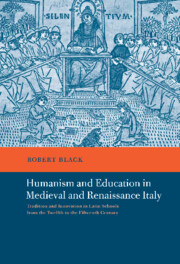 Humanism and Education in Medieval and Renaissance Italy
Humanism and Education in Medieval and Renaissance Italy Published online by Cambridge University Press: 25 July 2009
The history of education is particularly susceptible to influence from wider intellectual, philosophical and political movements; scholars have been tempted to justify their own intellectual formation by applauding or condemning the educational attitudes and assumptions of previous epochs. Historians have normally been university teachers and involvement in present-day educational issues has encouraged a tendency to see their own situation and ideals in past structures of learning. Justifications and critiques derived from contemporary educational preoccupations have frequently been imposed onto the remote past. It is necessary to begin this study of Italian pre-university education with these truisms in mind, because so much of what has been written about medieval and Renaissance education has been affected by contemporary agendas. An effort, however imperfect, must be made to identify modern preoccupations. This is particularly important because current polemics have often had positive effects, leading to new insights into the past, but these genuine perceptions must be distinguished from the mass of anachronistic distortion. Historical fashions have often had beneficial results: automatic scepticism in the face of innovation can be mistaken for trenchant criticism; here too one must weigh up fashion's advantages and limitations.
A case in point comes from the great age of Italian positivism, which at the turn of the twentieth century encouraged widespread research in local archives and led to the publication of numerous fundamental documentary studies, including Bellemo on Chioggia; Cecchetti, Bertanza and Della Santa and Segarizzi on Venice; Barsanti on Lucca; Debenedetti on Florence; Gabotto on Piedmont; Massa on Genoa; Zanelli on Pistoia and Battistini on Volterra.
To save this book to your Kindle, first ensure no-reply@cambridge.org is added to your Approved Personal Document E-mail List under your Personal Document Settings on the Manage Your Content and Devices page of your Amazon account. Then enter the ‘name’ part of your Kindle email address below. Find out more about saving to your Kindle.
Note you can select to save to either the @free.kindle.com or @kindle.com variations. ‘@free.kindle.com’ emails are free but can only be saved to your device when it is connected to wi-fi. ‘@kindle.com’ emails can be delivered even when you are not connected to wi-fi, but note that service fees apply.
Find out more about the Kindle Personal Document Service.
To save content items to your account, please confirm that you agree to abide by our usage policies. If this is the first time you use this feature, you will be asked to authorise Cambridge Core to connect with your account. Find out more about saving content to Dropbox.
To save content items to your account, please confirm that you agree to abide by our usage policies. If this is the first time you use this feature, you will be asked to authorise Cambridge Core to connect with your account. Find out more about saving content to Google Drive.